|
|
#821 |
|
⊙▃⊙
|
Daily Suspicious0bserver's Weather Post:
January 27, 2014 What's in the sky tonight? January 27, 2014 -In the dawn Tuesday morning the 28th, make a point to look low in the southeast to catch Venus with the waning crescent Moon to its right, as shown at lower right. A telescope shows that Venus too is a crescent! -The southeastern limb of the sun is crackling with C- and M-class solar flares. These explosions herald the return of old sunspot AR1944, which produced many strong flares earlier this month. For the past two weeks AR1944 has been transiting the farside of the sun. An uptick in solar activity is possible as it returns to the Earthside this week.  Astro Picture of the Day: January 27, 2014  There is a road that connects the Northern to the Southern Cross but you have to be at the right place and time to see it. The road, as pictured above, is actually the central band of our Milky Way Galaxy; the right place, in this case, is dark Laguna Cejar in Salar de Atacama of Northern Chile; and the right time was in early October, just after sunset. Many sky wonders were captured then, including the bright Moon, inside the Milky Way arch; Venus, just above the Moon; Saturn and Mercury, just below the Moon; the Large and Small Magellanic Clouds satellite galaxies, on the far left; red airglow near the horizon on the image left; and the lights of small towns at several locations across the horizon.
__________________
1st in Kommisar's 2009 SM Tournament 1st in I Love You`s 2009 New Year`s Tournament 3rd in EnR's Mashfest '08 tournament 5th in Phynx's Unofficial FFR Tournament 9th in D3 of the 2008-2009 4th Official FFR Tournament 10th in D5 of the 2010 5th Official FFR Tournament 10th in D6 of the 2011-2012 6th Official FFR Tournament FMO AAA Count: 71 FGO AAA Count: 10 Bluearrowll = The Canadian player who can not detect awkward patterns. If it's awkward for most people, it's normal for Terry. If the file is difficult but super straight forward, he has issues. If he's AAAing a FGO but then heard that his favorite Hockey team was losing by a point, Hockey > FFR PS: Cool AAA's Terry - I Love You An Alarm Clock's Haiku beep beep beep beep beep beep beep beep beep beep beep beep beep beep beep beep beep - ieatyourlvllol |
|
|

|
|
|
#822 |
|
⊙▃⊙
|
Daily Suspicious0bserver's Weather Post:
January 28, 2014 What's in the sky tonight? January 28, 2014 -Algol is at minimum brightness for a couple hours centered on 7:00 p.m. EST. In Wednesday's dawn, look for the eerily thin waning crescent Moon below Venus now. They're low in the southeast, as shown here. -China's moon rover, the Jade Rabbit, which made an historic landing in Sinus Iridum (the Bay of Rainbows) on Dec. 14th, is in trouble. Night is falling over the rover's landing site, and the rover should be going into hibernation to preserve power. China's space agency is reporting, however, that a "mechanical anomaly" may be interfering with the hibernation process. If so, the Jade Rabbit might not survive the extreme cold (-180 C) it is about to experience during two weeks of lunar night. Even if the rover fails, the mission is a success for China, which has joined the exclusive club of nations that have landed on the Moon. -Active sunspot AR1944, which produced many strong flares earlier this month, has returned from a two-week trip around the farside of the sun. It announced itself on Jan. 27th with an M4-class solar flare, shown here in an extreme UV image from the Solar Dynamics Observatory. According to tradition, sunspots that circle around the farside of the sun and re-appear are re-numbered. The new name of AR1944 is AR1967. That's how we shall refer to it from now on. Although AR1967 decayed during its absence, it is still potent. NOAA forecasters estimate a 5% chance of X-flares and a 50% chance of M-flares on Jan. 28th. Explosions probably won't be Earth-directed, however, because the active region is still near the sun's southeastern limb.  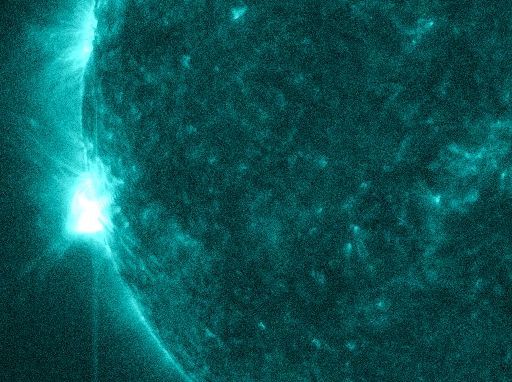 Astro Picture of the Day: January 28, 2014 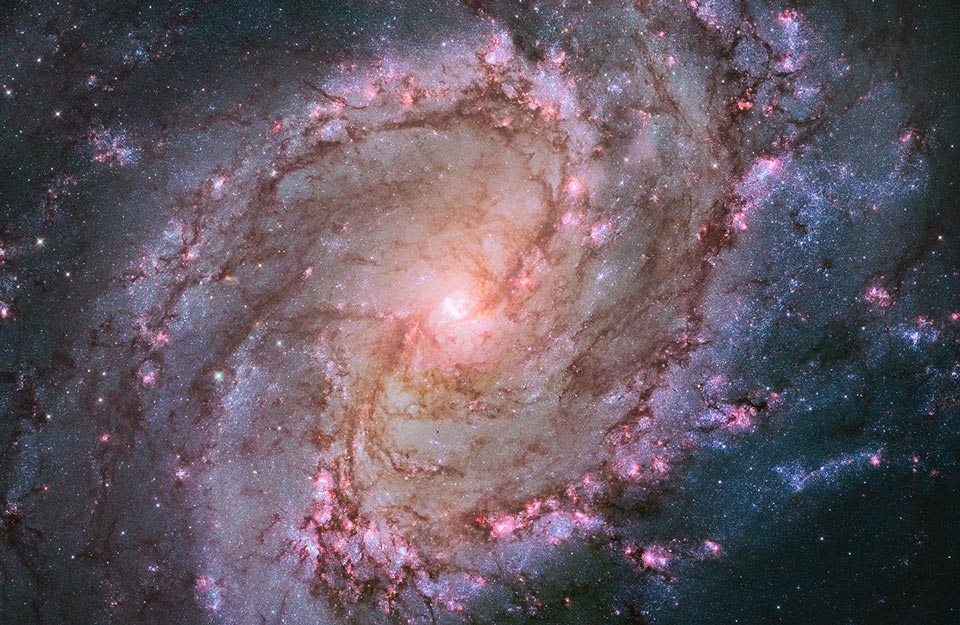 M83 is one of the closest and brightest spiral galaxies on the sky. Visible with binoculars in the constellation of Hydra, majestic spiral arms have prompted its nickname as the Southern Pinwheel. Although discovered 250 years ago, only much later was it appreciated that M83 was not a nearby gas cloud, but a barred spiral galaxy much like our own Milky Way Galaxy. M83, pictured above by the Hubble Space Telescope in a recently released image, is a prominent member of a group of galaxies that includes Centaurus A and NGC 5253, all of which lie about 15 million light years distant. Several bright supernova explosions have been recorded in M83. An intriguing double circumnuclear ring has been discovered at the center of of M83.
__________________
1st in Kommisar's 2009 SM Tournament 1st in I Love You`s 2009 New Year`s Tournament 3rd in EnR's Mashfest '08 tournament 5th in Phynx's Unofficial FFR Tournament 9th in D3 of the 2008-2009 4th Official FFR Tournament 10th in D5 of the 2010 5th Official FFR Tournament 10th in D6 of the 2011-2012 6th Official FFR Tournament FMO AAA Count: 71 FGO AAA Count: 10 Bluearrowll = The Canadian player who can not detect awkward patterns. If it's awkward for most people, it's normal for Terry. If the file is difficult but super straight forward, he has issues. If he's AAAing a FGO but then heard that his favorite Hockey team was losing by a point, Hockey > FFR PS: Cool AAA's Terry - I Love You An Alarm Clock's Haiku beep beep beep beep beep beep beep beep beep beep beep beep beep beep beep beep beep - ieatyourlvllol |
|
|

|
|
|
#823 |
|
Forum User
|
Awesome, I got a great view of venus this morning on my way to a work meeting that I was 12 hours early for.
Also I'm listening to an album with M83 on the cover of it as I post this too, cool.
__________________
     
|
|
|

|
|
|
#824 |
|
⊙▃⊙
|
Daily Suspicious0bserver's Weather Post:
January 29, 2014 What's in the sky tonight? January 29, 2014 -Jupiter this month turns the Winter Triangle into a bigger, brighter Winter Diamond. Its bottom is Sirius, its two side corners are Betelgeuse and Procyon, and Jupiter forms its top. The diamond tilts leftward in early evening and stands vertically in the south around 10 p.m. (depending on your location). -Earth is entering a stream of solar wind blowing almost 500 km/s or 1.1 million mph. First contact on Jan. 28th sparked tall curtains of light around the Arctic Circle. Harald Albrigtsen captured this picture of the display from Skulsfjord, Tromsø, Norway. "At first there was little auroral activity, but being patient paid off," says Albrigtsen. He photographed the explosion of light using a Nikon D600 digital camera set at ISO 3200 iso for 3 seconds. Arctic photographers, take note of those settings because more auroras are on the way. NOAA forecasters estimate a 25% to 40% chance of polar geomagnetic storms on Jan. 29-30 as Earth moves deeper into the solar wind stream. -Big sunspot AR1967 near the sun's southeastern limb is crackling with solar flares. As Jan. 29th unfolds it is producing an average of one impulsive M-class explosion every two hours. So far, none of the explosions has been Earth-directed, but future flares will be as the sunspot continues its slow turn toward our planet. NOAA forecasters have doubled the odds of an X-class flare in the next 24 hours to 10%. Meanwhile, M-class flares seem almost certain as the crackling continues. The primary dark core of AR1967 is twice as wide as Earth. This makes it an easy target for small telescopes equipped with solar filters. This morning at the Langkawi National Observatory in Malaysia, astronomer Karzaman Ahmad photographed the sunspot using an 11-inch Celestron." I wanted to take a closer look at the monster numbered AR1967," says Ahmad. "It is impressive."   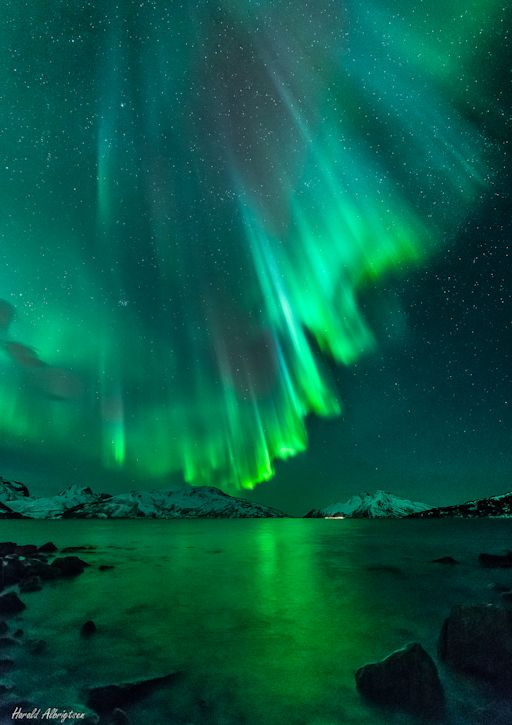 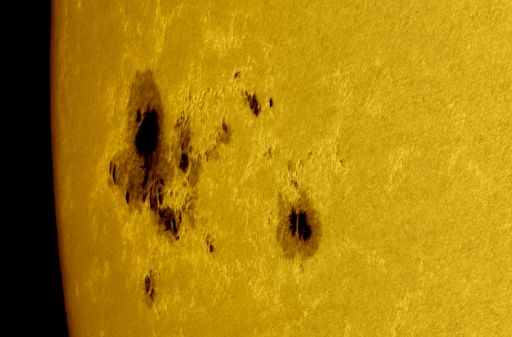 Astro Picture of the Day: January 29, 2014  What if a rock that looked like a jelly donut suddenly appeared on Mars? That's just what happened in front of the robotic Opportunity rover currently exploring the red planet. The unexpectedly placed rock, pictured above, was imaged recently by Opportunity after not appearing in other images taken as recently as twelve Martian days (sols) before. Given the intriguing mystery, the leading explanation is somewhat tame -- the rock was recently scattered by one of the rover's tires. Even so, the rock's unusual light tones surrounding a red interior created interest in its composition -- as well as causing it to be nicknamed Jelly Donut. A subsequent chemical analysis showed the rock has twice the abundance of manganese than any other rock yet examined -- an unexpected clue that doesn't yet fit into humanity's understanding of the Martian geologic history. Opportunity, just passing its 10-year anniversary on Mars, continues to explore the Murray Ridge section of the rim of 22-kilometer wide Endeavor Crater.
__________________
1st in Kommisar's 2009 SM Tournament 1st in I Love You`s 2009 New Year`s Tournament 3rd in EnR's Mashfest '08 tournament 5th in Phynx's Unofficial FFR Tournament 9th in D3 of the 2008-2009 4th Official FFR Tournament 10th in D5 of the 2010 5th Official FFR Tournament 10th in D6 of the 2011-2012 6th Official FFR Tournament FMO AAA Count: 71 FGO AAA Count: 10 Bluearrowll = The Canadian player who can not detect awkward patterns. If it's awkward for most people, it's normal for Terry. If the file is difficult but super straight forward, he has issues. If he's AAAing a FGO but then heard that his favorite Hockey team was losing by a point, Hockey > FFR PS: Cool AAA's Terry - I Love You An Alarm Clock's Haiku beep beep beep beep beep beep beep beep beep beep beep beep beep beep beep beep beep - ieatyourlvllol |
|
|

|
|
|
#825 |
|
⊙▃⊙
|
Daily Suspicious0bserver's Weather Post:
January 30, 2014 What's in the sky tonight? January 30, 2014 -On Thursday, Jan. 30th, the Moon will eclipse the sun for almost 2.5 hours. You have to be in space to see it. NASA's Solar Dynamics Observatory s set to record the "lunar transit," which begins at 1331 UTC or 8:31 EST. A simulation shows that approximately 90% of the sun will covered. SDO is solar powered, so mission controllers have charged-up the spacecraft's batteries to endure the blackout. Stay tuned for images during the eclipse! Astro Picture of the Day: January 30, 2014  Fixed to a tripod and looking east across the Kennedy Space Center's Turn Basin, a camera captured these star trails as a series of short exposures over a three hour period on the evening of January 23rd. Positioned just a few miles from Space Launch Complex 41 at Cape Canaveral Air Force Station, it also captured a spectacular night launch of an Atlas V rocket carrying NASA's Tracking and Data Relay Satellite TDRS-L. Creating the trails, the apparent motion of the stars through the sky is just a reflection of the daily rotation of planet Earth on its axis. But that rotation is also the reason the rocket streak follows a path arcing east across the Atlantic. Launching toward the east, in the direction of Earth's rotation, adds the rotation velocity to the rocket and reduces the fuel needed to reach orbit. A little ironically, TDRS-L is destined for a geostationary orbit. From there, 36,000 kilometers or so above the equator, it's orbital period will match Earth's rotation and the satellite will hang motionless in planet Earth's sky.
__________________
1st in Kommisar's 2009 SM Tournament 1st in I Love You`s 2009 New Year`s Tournament 3rd in EnR's Mashfest '08 tournament 5th in Phynx's Unofficial FFR Tournament 9th in D3 of the 2008-2009 4th Official FFR Tournament 10th in D5 of the 2010 5th Official FFR Tournament 10th in D6 of the 2011-2012 6th Official FFR Tournament FMO AAA Count: 71 FGO AAA Count: 10 Bluearrowll = The Canadian player who can not detect awkward patterns. If it's awkward for most people, it's normal for Terry. If the file is difficult but super straight forward, he has issues. If he's AAAing a FGO but then heard that his favorite Hockey team was losing by a point, Hockey > FFR PS: Cool AAA's Terry - I Love You An Alarm Clock's Haiku beep beep beep beep beep beep beep beep beep beep beep beep beep beep beep beep beep - ieatyourlvllol |
|
|

|
|
|
#826 |
|
⊙▃⊙
|
Daily Suspicious0bserver's Weather Post:
January 31, 2014 What's in the sky tonight? January 31, 2014 -The Moon is back in the evening sky, as a thin waxing crescent to the lower right of Mercury. Look very low above the west-southwest horizon in twilight. -Yesterday, Jan. 30th, big sunspot AR1967 unleashed a strong M6-class solar flare. The explosion sent a CME racing away from the blast site faster than 1400 km/s (3 million mph). The cloud appears to have an Earth-directed component, and could deliver a glancing blow to our planet's magnetic field on Feb 1st. -On Jan. 30th, the Moon passed almost directly in front of the sun. No darkness fell on Earth, however, because the "lunar transit" was only visible from space. NASA's Solar Dynamics Observatory (SDO) recorded the entire passage from geosynchronous orbit. At maximum eclipse as much as 90% of the sun was covered. SDO is solar powered, but it did not "brown out" because mission controllers put an extra charge on the spacecraft's batteries ahead of time. Every year, SDO observes multiple lunar transits. This one, lasting almost 2.5 hours, was the longest in the history of the spacecraft's 4 year mission. A highlight of the movie occurs just after the eclipse is finished when sunspot AR1967 erupts. A plume of hot plasma flies away from one side of the sun just as the Moon is exiting the other. That eruption is the source of the CME that could deliver a glancing blow to Earth's magnetic field on Feb. 1st.  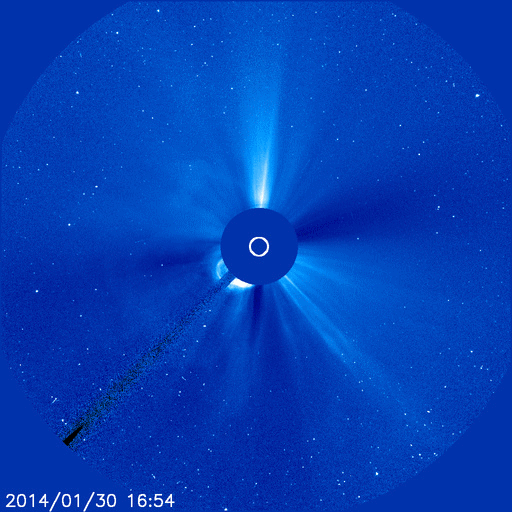 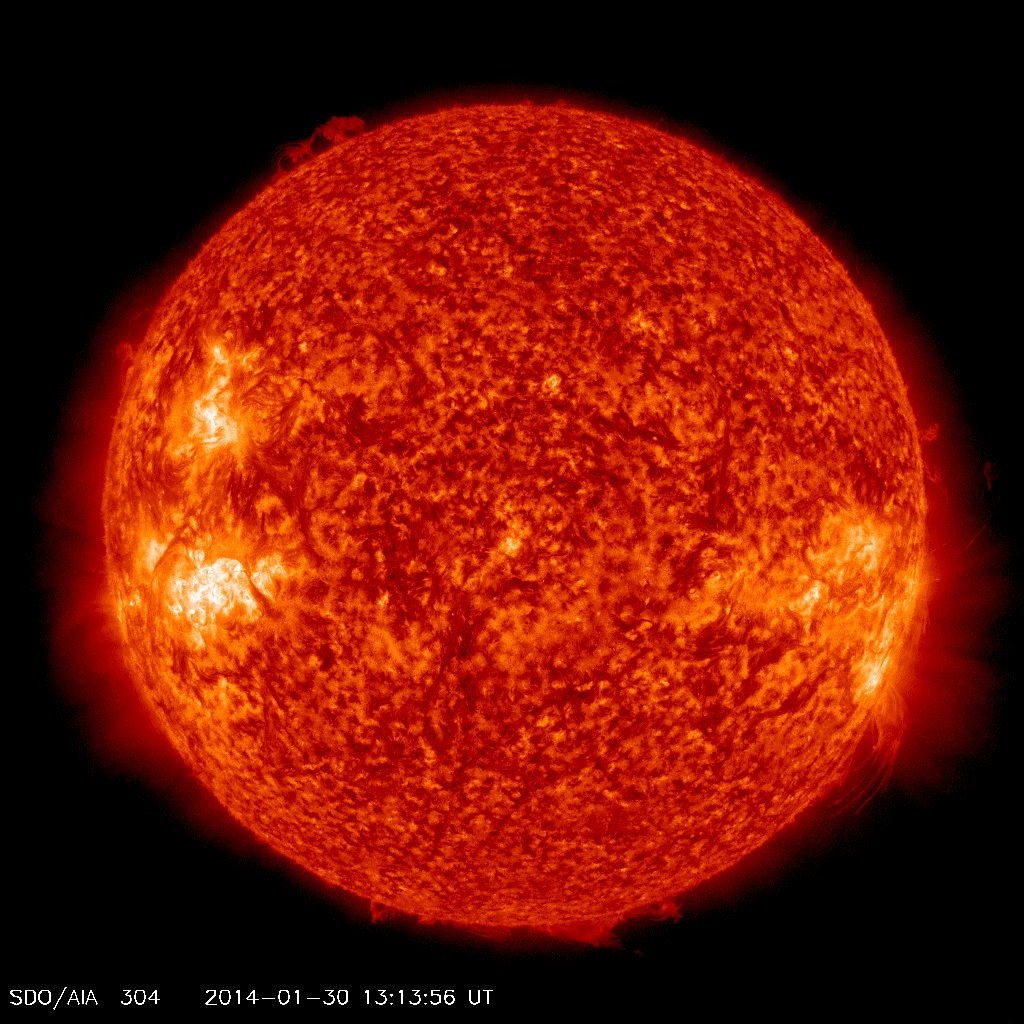 Astro Picture of the Day: January 31, 2014 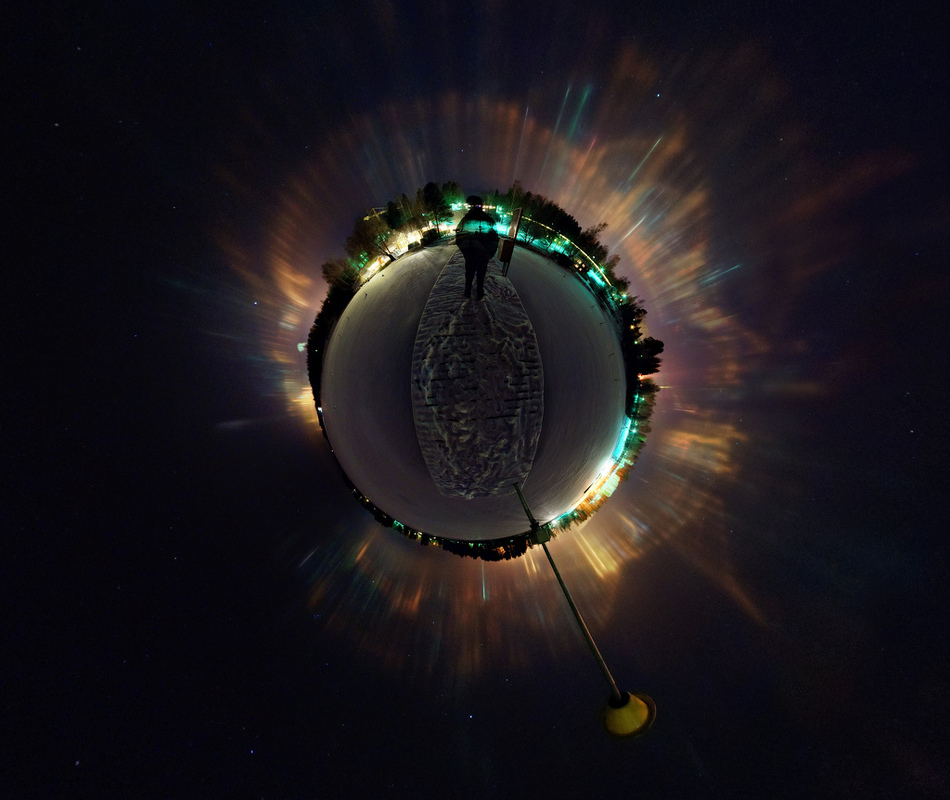 Eerie pillars of light ring the edges of this snowy little planet. Of course the little planet is planet Earth, shown in a nadir-to-zenith, around-the-horizon, little planet projection. The spherical panoramic image mosaic maps a view from Siilinjärvi in eastern Finland. Flat ice crystals, like those more often found in high, thin clouds, are gently fluttering in very cold air near the surface. The pillars of light appear as their briefly horizontal facets reflect upward directed light from ground sources downward, toward the observer. In fact, the fluttering crystals produce an effect analogous to the shimmering columns of moonlight or sunlight reflected by surface waves across water.
__________________
1st in Kommisar's 2009 SM Tournament 1st in I Love You`s 2009 New Year`s Tournament 3rd in EnR's Mashfest '08 tournament 5th in Phynx's Unofficial FFR Tournament 9th in D3 of the 2008-2009 4th Official FFR Tournament 10th in D5 of the 2010 5th Official FFR Tournament 10th in D6 of the 2011-2012 6th Official FFR Tournament FMO AAA Count: 71 FGO AAA Count: 10 Bluearrowll = The Canadian player who can not detect awkward patterns. If it's awkward for most people, it's normal for Terry. If the file is difficult but super straight forward, he has issues. If he's AAAing a FGO but then heard that his favorite Hockey team was losing by a point, Hockey > FFR PS: Cool AAA's Terry - I Love You An Alarm Clock's Haiku beep beep beep beep beep beep beep beep beep beep beep beep beep beep beep beep beep - ieatyourlvllol |
|
|

|
|
|
#827 |
|
⊙▃⊙
|
Daily Suspicious0bserver's Weather Post:
February 1, 2014 What's in the sky tonight? February 1, 2014 -Mercury now shines below the thin crescent Moon low in the west-southwest after sunset. -Jupiter's moon Ganymede casts its tiny black shadow onto Jupiter from 5:42 to 8:22 p.m. EST. Jupiter's Great Red Spot crosses the planet's central meridian around 11:48 p.m. EST (8:48 p.m. PST). -NASA engineers are building a refrigerator for the International Space Station that can make atoms colder than anything else in the known universe. Inside this "Cold Atom Lab," researchers hope to discover new forms of matter and novel quantum phenomena. Get the full story from Science@NASA here: http://science.nasa.gov/science-news...0jan_coldspot/ -Big sunspot AR1967 is crackling with solar flares and hurling CMEs into space. The biggest CME so far was propelled away from the sun on Jan. 30th by an M6-class explosion in the sunspot's magnetic canopy. It is expected to reach Earth on Feb. 2nd. The blast was not squarely Earth-directed. Instead, it will deliver a glancing blow to our planet's magnetic field. NOAA forecasters estimate a 45% chance of polar geomagnetic storms when the cloud arrives on Sunday. High-latitude sky watchers should be alert for auroras.   Astro Picture of the Day: February 1, 2014 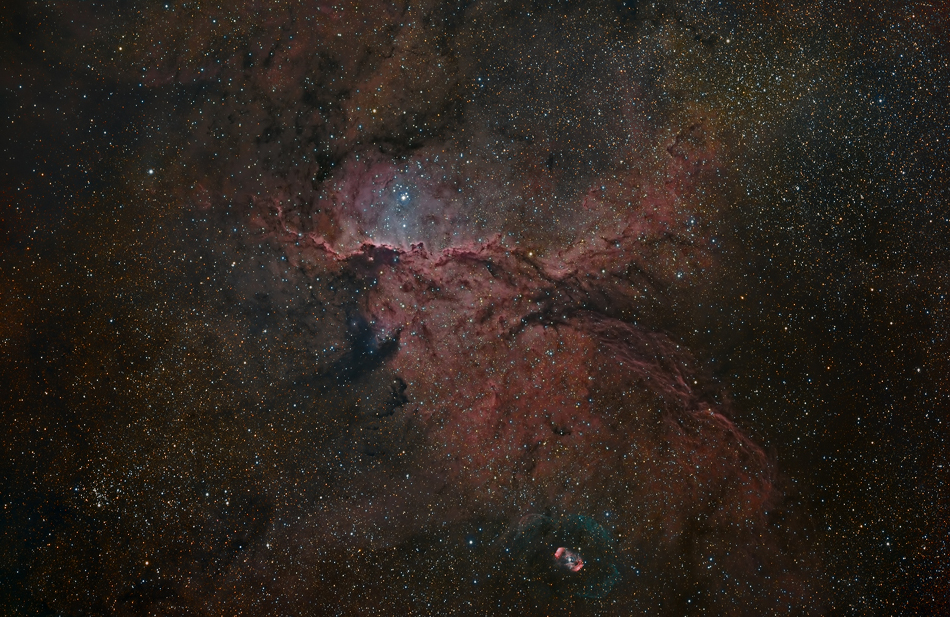 Fantastic shapes lurk in clouds of glowing gas in NGC 6188, about 4,000 light-years away. The emission nebula is found near the edge of a large molecular cloud unseen at visible wavelengths, in the southern constellation Ara. Massive, young stars of the embedded Ara OB1 association were formed in that region only a few million years ago, sculpting the dark shapes and powering the nebular glow with stellar winds and intense ultraviolet radiation. The recent star formation itself was likely triggered by winds and supernova explosions, from previous generations of massive stars, that swept up and compressed the molecular gas. Joining NGC 6188 on this cosmic canvas is rare emission nebula NGC 6164, also created by one of the region's massive O-type stars. Similar in appearance to many planetary nebulae, NGC 6164's striking, symmetric gaseous shroud and faint halo surround its bright central star near the bottom edge. The impressively wide field of view spans over 3 degrees (six full Moons), corresponding to over 200 light years at the estimated distance of NGC 6188. Narrowband image data has been included in the natural looking color composite, adding to deep red emission from hydrogen and sulfur atoms and the blue-green light of oxygen atoms.
__________________
1st in Kommisar's 2009 SM Tournament 1st in I Love You`s 2009 New Year`s Tournament 3rd in EnR's Mashfest '08 tournament 5th in Phynx's Unofficial FFR Tournament 9th in D3 of the 2008-2009 4th Official FFR Tournament 10th in D5 of the 2010 5th Official FFR Tournament 10th in D6 of the 2011-2012 6th Official FFR Tournament FMO AAA Count: 71 FGO AAA Count: 10 Bluearrowll = The Canadian player who can not detect awkward patterns. If it's awkward for most people, it's normal for Terry. If the file is difficult but super straight forward, he has issues. If he's AAAing a FGO but then heard that his favorite Hockey team was losing by a point, Hockey > FFR PS: Cool AAA's Terry - I Love You An Alarm Clock's Haiku beep beep beep beep beep beep beep beep beep beep beep beep beep beep beep beep beep - ieatyourlvllol |
|
|

|
|
|
#828 |
|
⊙▃⊙
|
Daily Suspicious0bserver's Weather Post:
February 2, 2014 What's in the sky tonight? February 2, 2014 -Mercury is visible in evening twilight, low in the west-southwest. It fades rapidly, from magnitude –0.6 to +0.7 this week. -Venus (magnitude –4.8) shines brightly in the dawn; look southeast. In a telescope Venus is a crescent, thickening from 14% to 19% sunlit this week. News Posted Today: January 31, 2014 Mystery of the Missing Galaxy Clusters  Astro Picture of the Day: February 2, 2014 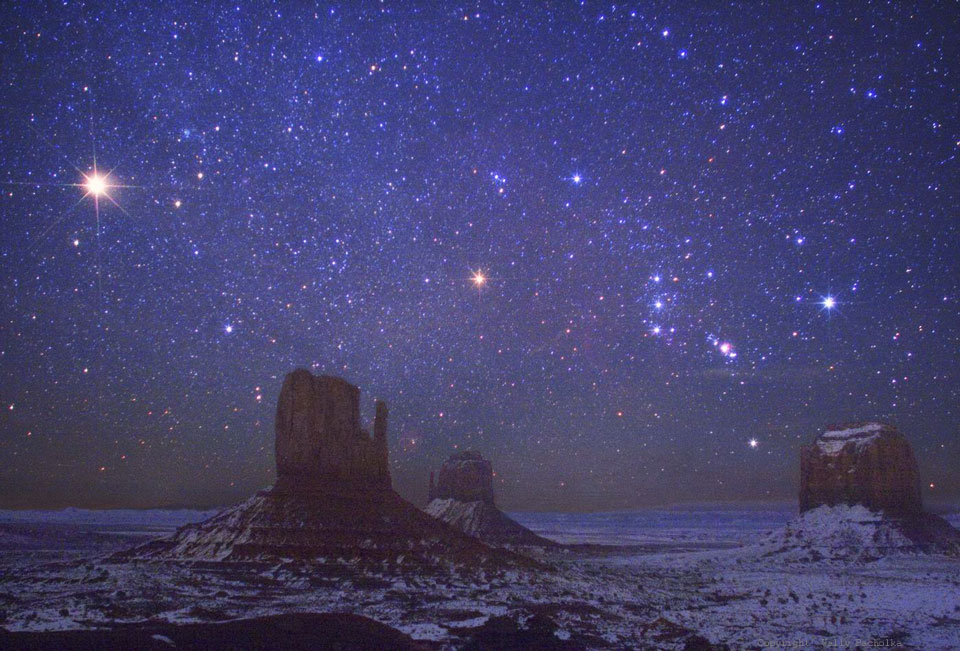 Welcome to The World At Night. Sharing the night sky seen around the world, this view from Monument Valley, USA includes a picturesque foreground of famous buttes. Buttes are composed of hard rock left behind after water eroded away the surrounding soft rock. The two buttes on the image left are known as the Mittens, while Merrick Butte is on the right. Recorded in 2007 December, planet Mars is at the left of the skyscape, a glowing beacon of orange that is the brightest object in the frame. To the right of Mars lies the constellation of Orion. Betelgeuse is the reddish star near the center and the Belt of Orion and the Orion Nebula are farther right. Finally, the bright blue star Rigel appears above Merrick Butte in this stunning view of The World At Night.
__________________
1st in Kommisar's 2009 SM Tournament 1st in I Love You`s 2009 New Year`s Tournament 3rd in EnR's Mashfest '08 tournament 5th in Phynx's Unofficial FFR Tournament 9th in D3 of the 2008-2009 4th Official FFR Tournament 10th in D5 of the 2010 5th Official FFR Tournament 10th in D6 of the 2011-2012 6th Official FFR Tournament FMO AAA Count: 71 FGO AAA Count: 10 Bluearrowll = The Canadian player who can not detect awkward patterns. If it's awkward for most people, it's normal for Terry. If the file is difficult but super straight forward, he has issues. If he's AAAing a FGO but then heard that his favorite Hockey team was losing by a point, Hockey > FFR PS: Cool AAA's Terry - I Love You An Alarm Clock's Haiku beep beep beep beep beep beep beep beep beep beep beep beep beep beep beep beep beep - ieatyourlvllol |
|
|

|
|
|
#829 |
|
⊙▃⊙
|
Daily Suspicious0bserver's Weather Post:
February 3, 2014 What's in the sky tonight? February 3, 2014 -The crescent Moon this evening shines to the left of the Great Square of Pegasus. The Great Square is tipped up onto one corner, as it always is at this time of year. -A CME expected to sideswipe Earth's magnetic field on Feb 2nd did not arrive on time. A new analysis by NOAA forecasters suggests it will reach Earth on Feb. 4th instead. The late arrival could spark minor geomagnetic storms and auroras on Tuesday. -Solar activity reached high levels yesterday with seven M-class solar flares and three CMEs. Almost all of the explosions were produced by monster sunspot AR1967, shown here in a photo from Chris Schur of Payson, Arizona. AR1967 is wider than the planet Jupiter and its primary dark cores are big enough to swallow Earth many times over. The scale of the thing makes it an easy target for backyard solar telescopes. "I used an Explore Scientific AR152 to take the picture," says Schur. "This is one of the most photogenic sunspots I have ever seen." AR1967 has a 'delta-class' magnetic field that harbors energy for strong eruptions. The growing complexity of the region has prompted NOAA forecasters to boost the odds of X-flares to 50% during the next 24 hours. Because AR1967 is near the center of the solar disk, any eruptions will be squarely Earth directed. Astro Picture of the Day: February 3, 2014  Where has the Yutu rover been on the Moon? Arriving in 2013 mid-December, the Chinese Yutu robotic rover has spent some of the past month and a half exploring Mare Imbrium on Earth's Moon. Because it uses solar power, the mechanical Jade Rabbit goes into sleep mode to endure the two-week long lunar night. Pictured above is a digitally created time-lapse composite panorama showing the region surrounding the Chang'e 3 lander, capturing the desk-sized rover in three positions. On the far right, Yutu is seen heading south to investigate greener pastures, likely never to return to its lander again.
__________________
1st in Kommisar's 2009 SM Tournament 1st in I Love You`s 2009 New Year`s Tournament 3rd in EnR's Mashfest '08 tournament 5th in Phynx's Unofficial FFR Tournament 9th in D3 of the 2008-2009 4th Official FFR Tournament 10th in D5 of the 2010 5th Official FFR Tournament 10th in D6 of the 2011-2012 6th Official FFR Tournament FMO AAA Count: 71 FGO AAA Count: 10 Bluearrowll = The Canadian player who can not detect awkward patterns. If it's awkward for most people, it's normal for Terry. If the file is difficult but super straight forward, he has issues. If he's AAAing a FGO but then heard that his favorite Hockey team was losing by a point, Hockey > FFR PS: Cool AAA's Terry - I Love You An Alarm Clock's Haiku beep beep beep beep beep beep beep beep beep beep beep beep beep beep beep beep beep - ieatyourlvllol |
|
|

|
|
|
#830 |
|
⊙▃⊙
|
Daily Suspicious0bserver's Weather Post:
February 4, 2014 What's in the sky tonight? February 4, 2014 -Jupiter's moon Io disappears behind Jupiter's western limb around 8:57 p.m. EST. Twenty minutes later, Jupiter's Great Red Spot crosses the planet's central meridian. Finally, Io reappears out of eclipse from Jupiter's shadow, just east of the planet, around 11:56 p.m. EST (8:56 p.m. PST). -NOAA forecasters estimate an 80% chance of M-flares and a 50% chance of X-flares on Feb. 4th. The source would be giant sunspot AR1967, shown here seething with activity in a photo from amateur astronomer Sergio Castillo of Inglewood, California. In Castillo's photo, a pair of magnetic filaments reaches out from the heart of the active region, where multiple dark cores big enough to swallow Earth are crackling with flares. "The activity in this region is just amazing," says Castillo. AR1967 has an unstable 'delta-class' magnetic field that harbors energy for strong flares and CMEs. Any eruptions today will surely be Earth-directed as the active region crosses the center of the solar disk.  Astro Picture of the Day: February 4, 2014 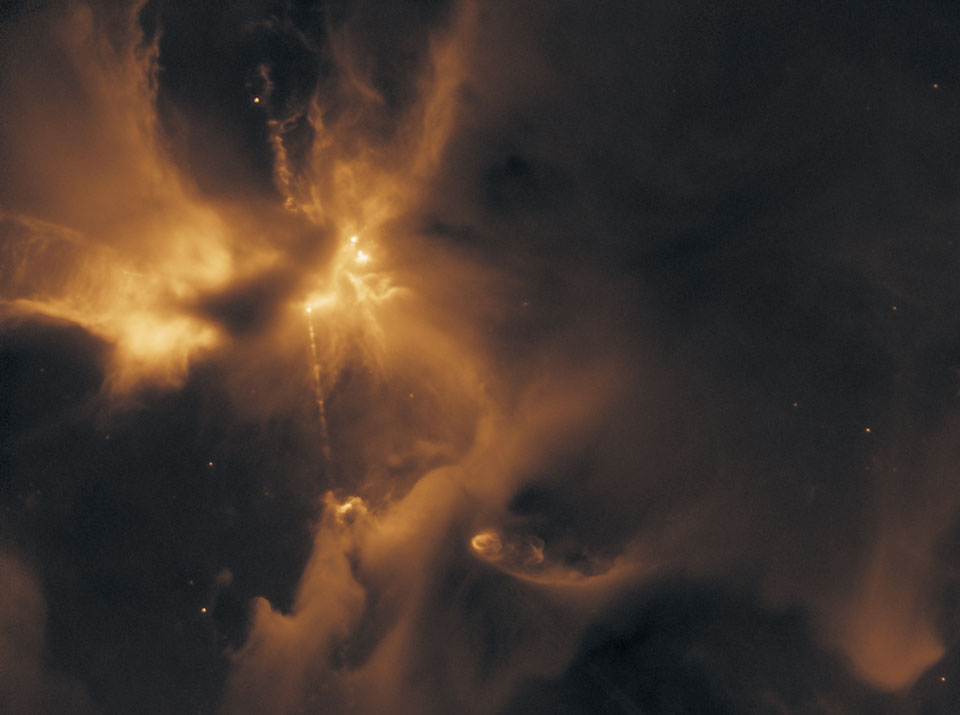 If you visit HH 24, don't go near the particle beam jet. This potential future travel advisory might be issued because the powerful jet likely contains electrons and protons moving hundreds of kilometers per second. The above image was taken by the Hubble Space Telescope in infrared light in order to better understand turbulent star forming regions known as Young Stellar Objects (YSOs). Frequently when a star forms, a disk of dust and gas circles the YSO causing a powerful central jets to appear. In this case, the energetic jets are creating, at each end, Herbig-Haro object 24 (HH 24), as they slam into the surrounding interstellar gas. The entire star forming region lies about 1,500 light years distant in the Orion B molecular cloud complex. Due to their rarity, jets like that forming HH 24 are estimated to last only a few thousand years.
__________________
1st in Kommisar's 2009 SM Tournament 1st in I Love You`s 2009 New Year`s Tournament 3rd in EnR's Mashfest '08 tournament 5th in Phynx's Unofficial FFR Tournament 9th in D3 of the 2008-2009 4th Official FFR Tournament 10th in D5 of the 2010 5th Official FFR Tournament 10th in D6 of the 2011-2012 6th Official FFR Tournament FMO AAA Count: 71 FGO AAA Count: 10 Bluearrowll = The Canadian player who can not detect awkward patterns. If it's awkward for most people, it's normal for Terry. If the file is difficult but super straight forward, he has issues. If he's AAAing a FGO but then heard that his favorite Hockey team was losing by a point, Hockey > FFR PS: Cool AAA's Terry - I Love You An Alarm Clock's Haiku beep beep beep beep beep beep beep beep beep beep beep beep beep beep beep beep beep - ieatyourlvllol |
|
|

|
|
|
#831 |
|
⊙▃⊙
|
Daily Suspicious0bserver's Weather Post:
February 5, 2014 What's in the sky tonight? February 5, 2014 -The biggest and brightest asteroids, 1 Ceres and 4 Vesta respectively, are only about 4° apart in eastern Virgo in the early morning hours. They're magnitude 8.2 and 7.2, respectively. -A CME expected to sideswipe Earth's magnetic field on Feb. 4th missed. The solar wind around our planet was undisturbed by the distant passage of the cloud, which left the sun on Jan. 31st. Astro Picture of the Day: February 5, 2014 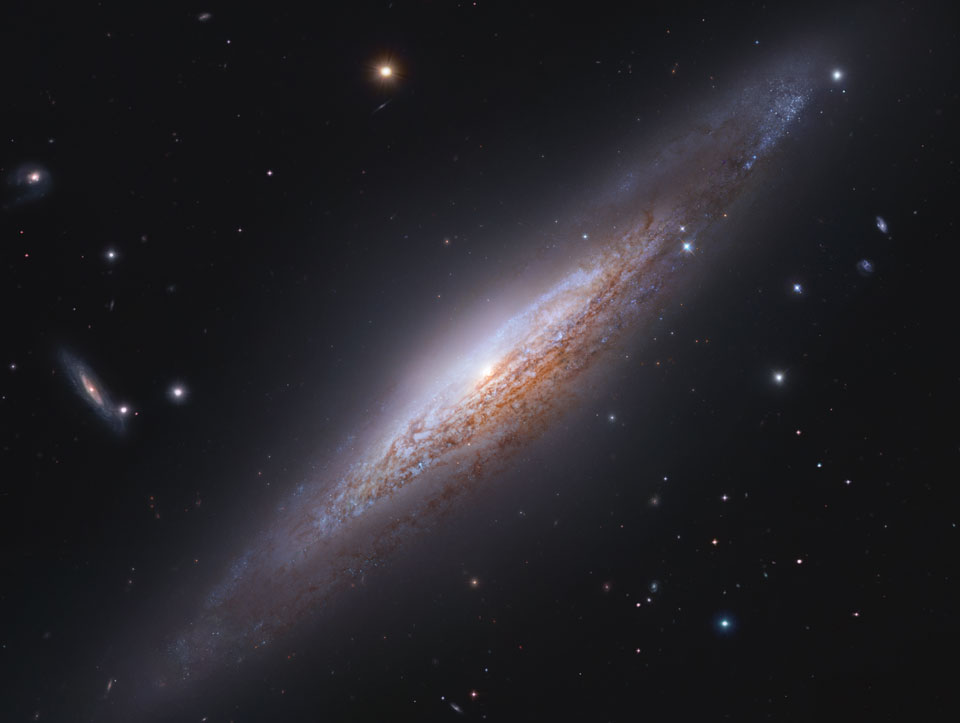 Does spiral galaxy NGC 2683 have a bar across its center? Being so nearly like our own barred Milky Way Galaxy, one might guess it has. Being so nearly edge-on, however, it is hard to tell. Either way, this gorgeous island universe, cataloged as NGC 2683, lies a mere 20 million light-years distant in the northern constellation of the Cat (Lynx). NGC 2683 is seen nearly edge-on in this cosmic vista combining data and images from the ground-based Subaru telescope and the space-based Hubble Space Telescope. More distant galaxies are seen scattered in the background. Blended light from a large population of old yellowish stars forms the remarkably bright galactic core. Starlight silhouettes the dust lanes along winding spiral arms, dotted with the telltale blue glow of young star clusters in this galaxy's star forming regions.
__________________
1st in Kommisar's 2009 SM Tournament 1st in I Love You`s 2009 New Year`s Tournament 3rd in EnR's Mashfest '08 tournament 5th in Phynx's Unofficial FFR Tournament 9th in D3 of the 2008-2009 4th Official FFR Tournament 10th in D5 of the 2010 5th Official FFR Tournament 10th in D6 of the 2011-2012 6th Official FFR Tournament FMO AAA Count: 71 FGO AAA Count: 10 Bluearrowll = The Canadian player who can not detect awkward patterns. If it's awkward for most people, it's normal for Terry. If the file is difficult but super straight forward, he has issues. If he's AAAing a FGO but then heard that his favorite Hockey team was losing by a point, Hockey > FFR PS: Cool AAA's Terry - I Love You An Alarm Clock's Haiku beep beep beep beep beep beep beep beep beep beep beep beep beep beep beep beep beep - ieatyourlvllol |
|
|

|
|
|
#832 |
|
Forum User
|
Those pictures of the day always put in me in awe. Great stuff. I NEED to go to some of these places :I
__________________
     
|
|
|

|
|
|
#833 |
|
⊙▃⊙
|
Daily Suspicious0bserver's Weather Post:
February 6, 2014 What's in the sky tonight? February 6, 2014 -First-quarter Moon. The Moon shines at the Aries-Taurus border, below the Pleiades throughout the evening hours. -Polar geomagnetic storms are possible on Saturdy, Feb. 8th, when a solar wind stream and a minor CME are expected to hit Earth's magnetic field. This will not be a major storm, but the double-impact could spark high-latitude auroras. -There is a place on Earth where you can see auroras almost every clear night even when there is no geomagnetic storm. It is under the auroral oval. The auroral oval is a donut of light around the poles which never goes completely dark because it is excited by energetic particles raining down from Earth's magnetosphere. Feb. 3rd was a very good night to be under the oval. "What an amazing night this was!" says Alan Dyer of Churchill, Manitoba, Canada. "On the night of Feb 3-4, despite all indicators showing quiet levels of activity, the sky exploded with a stunning all-sky display of rippling curtains across the sky. Churchill is under the prime auroral oval, so we see Northern Lights almost every clear night, even when official indicators are reading low or no geomagnetic storms." "These images are from the Churchill Northern Studies Centre, a non-profit research institute for Arctic science and that also offers aurora-watching and other Arctic tours through the year, including polar bear viewing in the autumn," he continues. "No words can describe the view of rapidly waving curtains of light rippling from horizon to horizon. All the tour group members left satisfied they had seen the celestial experience of a lifetime." According to NOAA forecasters there is only a 5% chance of geomagnetic storms on Feb. 6th. That's more than enough, however, under the oval. -Carried along by the sun's 27-day rotation, big sunspot AR1967 is turning away from Earth. Ironically this is making the active region even more dangerous. AR1967 is moving toward a location where the sun's spiraling magnetic field is well-connected to our planet and energetic particles can be funneled in our direction. An explosion there could spark a radiation storm around Earth. AR1967 has a 'beta-gamma-delta' magnetic field that harbors energy for strong eruptions. The past 24 hours has been relatively quiet, but that could be the calm before the storm. NOAA forecasters estimate an 80% chance of M-class solar flares and a 25% chance of X-class solar flares on Feb. 6th. 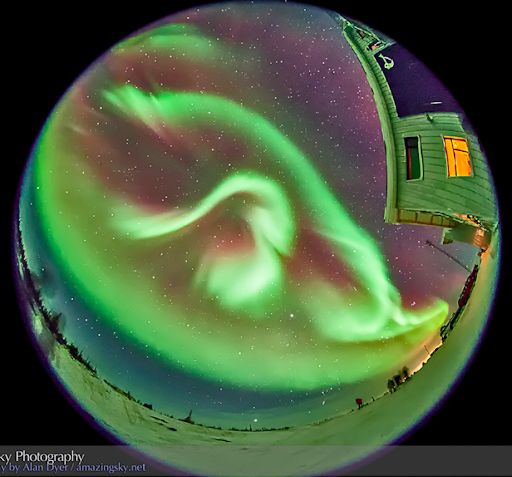 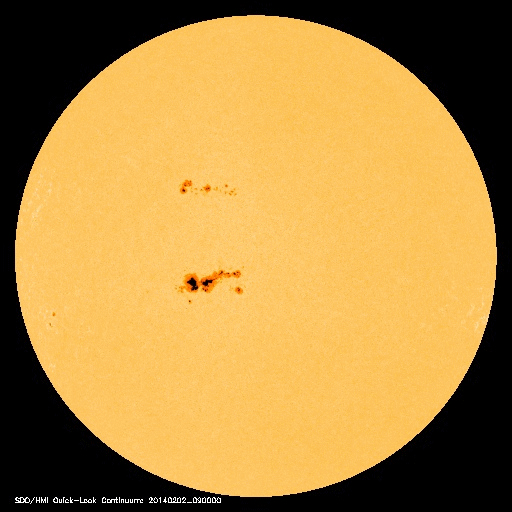 Astro Picture of the Day: February 6, 2014 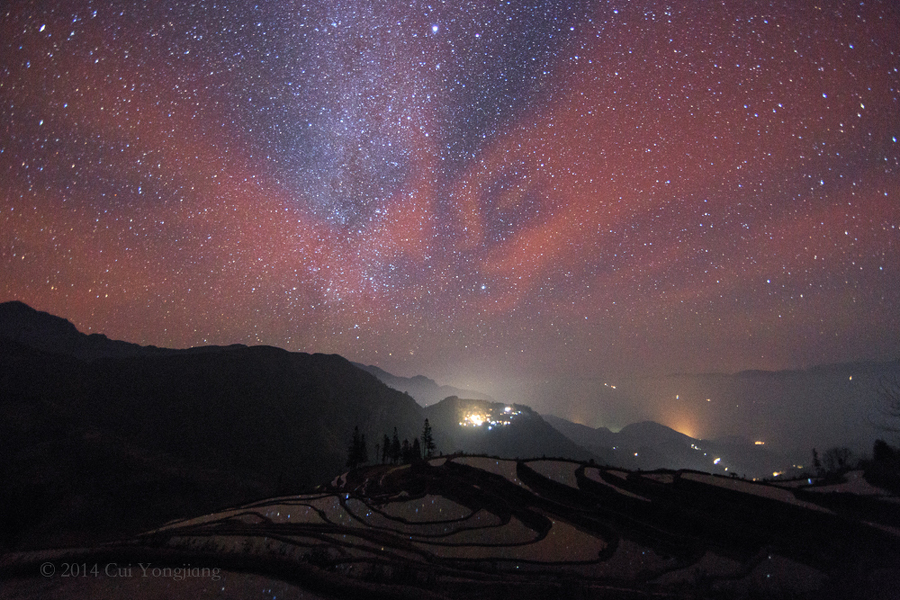 Long after sunset on January 25 an unusually intense red airglow floods this south-looking skyscape. The scene was recorded with a long exposure using a digital camera over Yunnan Province in southwest China. At best faintly visible to the eye, the lingering airglow is due to chemiluminescence, the production of light through chemical excitation. Originating at an altitude similar to aurora, it can found around the globe. The chemical energy is initially provided by the Sun's extreme ultraviolet radiation On this night, despite the luminous atmosphere, the band of the Milky Way clearly stretches above the horizon with bright star Sirius near the top of the frame. Both airglow and starry sky are beautifully reflected in region's watery Yuanyang rice terraces below.
__________________
1st in Kommisar's 2009 SM Tournament 1st in I Love You`s 2009 New Year`s Tournament 3rd in EnR's Mashfest '08 tournament 5th in Phynx's Unofficial FFR Tournament 9th in D3 of the 2008-2009 4th Official FFR Tournament 10th in D5 of the 2010 5th Official FFR Tournament 10th in D6 of the 2011-2012 6th Official FFR Tournament FMO AAA Count: 71 FGO AAA Count: 10 Bluearrowll = The Canadian player who can not detect awkward patterns. If it's awkward for most people, it's normal for Terry. If the file is difficult but super straight forward, he has issues. If he's AAAing a FGO but then heard that his favorite Hockey team was losing by a point, Hockey > FFR PS: Cool AAA's Terry - I Love You An Alarm Clock's Haiku beep beep beep beep beep beep beep beep beep beep beep beep beep beep beep beep beep - ieatyourlvllol |
|
|

|
|
|
#834 |
|
⊙▃⊙
|
Heading 350km north to Algonquin Park for Winter Camping and astrophotography trip today until very late Sunday. Due to this thread no longer being a stickied thread, it's necessary for it to keep running to stay on the front page. Sky Kitten will be manning the posts over the weekend while I hope for good weather. Forecast for tonight looks like snow, -23, with a potential clearing spot between 10am-2am. We'll see what happens.
Daily Suspicious0bserver's Weather Post: February 7, 2014 What's in the sky tonight? February 7, 2014 -This season, Jupiter turns the Winter Triangle into a bigger, brighter Winter Diamond! The Diamond's bottom is Sirius, its two side corners are Betelgeuse and Procyon, and Jupiter forms its top. It tilts leftward in early evening, then stands vertically in the south around 9 p.m. (depending on your location east or west in your time zone). -Polar geomagnetic storms are possible on Saturday, Feb. 8th, when a solar wind stream and a minor CME are expected to hit Earth's magnetic field. This will not be a major storm, but the double-impact could spark high-latitude auroras. -All week long, big sunspot AR1967 has has been crackling with activity, seemingly on the edge of producing an X-class solar flare. That hasn't happened. However, a new sunspot growing alongside AR1967 could push things over the edge. Emerging active region AR1968 has an unstable 'beta-gamma-delta' magnetic field that harbors energy for strong explosions. NOAA forecasters estimate an 60% chance of M-class solar flares and a 20% chance of X-class solar flares on Feb. 7th. Last night in Key West, Florida, Scott Wilson looked out over the Gulf of Mexico and saw the two big sunspots melting into the sea: The strange shape of the sun in Wilson's picture is a mirage caused by refraction in warm air just above the sea surface. There are many types of sunset mirages. This one is called the "Omega Sun" because the sun resembles the Greek letter omega. 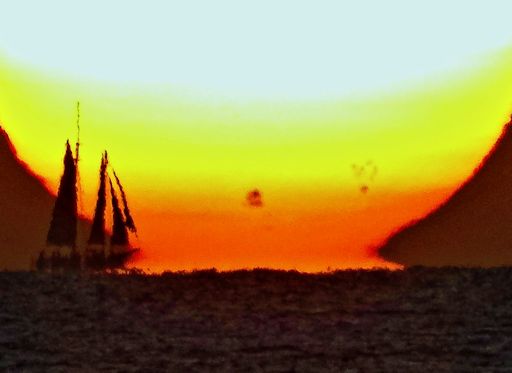 Astro Picture of the Day: February 7, 2014 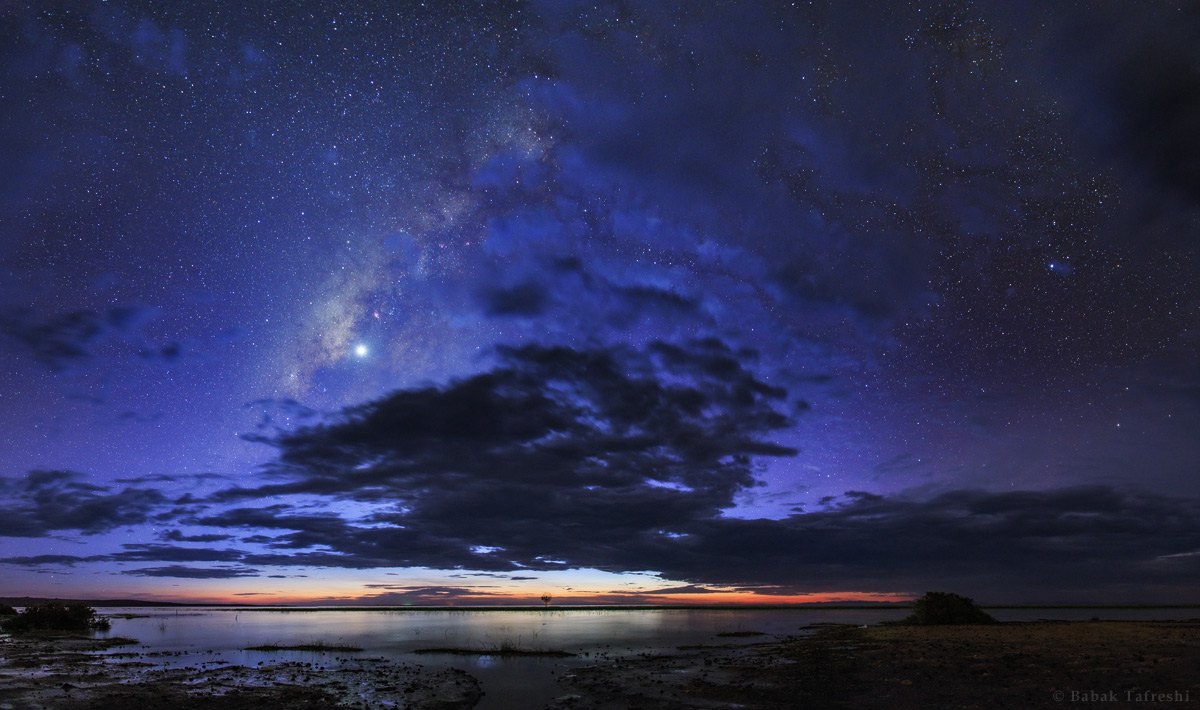 Stars come out as evening twilight fades in this serene skyscape following the Persian proverb "Night hides the world, but reveals a universe." In the scene from last November, the Sun is setting over northern Kenya and the night will soon hide the shores of Lake Turkana, home to many Nile crocodiles. That region is also known as the cradle of humankind for its abundance of hominid fossils. A brilliant Venus, then the world's evening star, dominates the starry night above. But also revealed are faint stars, cosmic dust clouds, and glowing nebulae along the graceful arc of our own Milky Way galaxy.
__________________
1st in Kommisar's 2009 SM Tournament 1st in I Love You`s 2009 New Year`s Tournament 3rd in EnR's Mashfest '08 tournament 5th in Phynx's Unofficial FFR Tournament 9th in D3 of the 2008-2009 4th Official FFR Tournament 10th in D5 of the 2010 5th Official FFR Tournament 10th in D6 of the 2011-2012 6th Official FFR Tournament FMO AAA Count: 71 FGO AAA Count: 10 Bluearrowll = The Canadian player who can not detect awkward patterns. If it's awkward for most people, it's normal for Terry. If the file is difficult but super straight forward, he has issues. If he's AAAing a FGO but then heard that his favorite Hockey team was losing by a point, Hockey > FFR PS: Cool AAA's Terry - I Love You An Alarm Clock's Haiku beep beep beep beep beep beep beep beep beep beep beep beep beep beep beep beep beep - ieatyourlvllol |
|
|

|
|
|
#835 |
|
Crazy Cat Lady
Community Manager, User Support
Join Date: Aug 2007
Location: Ontario, Canada
Age: 30
Posts: 1,079
|
Daily Suspicious0bserver's Weather Post:
February 8, 2014 What's in the sky tonight? February 8, 2014 -Look to the right of the Moon after dinnertime for Aldebaran. Below the Moon stands Orion. -Jupiter (magnitude –2.6, in Gemini) dominates the eastern sky in early evening. It crosses nearly overhead (for mid-northern observers) around 9 or 10 p.m. In a telescope Jupiter remains a big 46 or 45 arcseconds wide. Astro Picture of the Day: February 8, 2014  This sharp telescopic field of view holds two bright galaxies. Barred spiral NGC 5101 (top right) and nearly edge-on system NGC 5078 are separated on the sky by about 0.5 degrees or about the apparent width of a full moon. Found within the boundaries of the serpentine constellation Hydra, both are estimated to be around 90 million light-years away and similar in size to our own large Milky Way galaxy. In fact, if they both lie at the same distance their projected separation would be only 800,000 light-years or so. That's easily less than half the distance between the Milky Way and the Andromeda Galaxy. NGC 5078 is interacting with a smaller companion galaxy, cataloged as IC 879, seen just below and left of the larger galaxy's bright core. Even more distant background galaxies are scattered around the colorful field. Some are even visible right through the face-on disk of NGC 5101. But the prominent spiky stars are in the foreground, well within our own Milky Way.
__________________
 FMO AAAs (22): Heavenly Spores, .357 Magnum, Pure Ruby, VS Boss Battle, Black, You Goddamn Fish, Faint Breath, Epilogue, Crimson Flood, Zombie Killing Blood Spilling, Saffron City (offline), Fast Asleep, R2, Her Majesty, Defection, Happy Meal, Bit Blue, Stupor of Peace, Tightwad, Progressive jikuu shoujo! Urashima Taroko-chan!, Annihilator Method, Skyfire Ace Last edited by Sky Kitten; 02-8-2014 at 06:10 AM.. Reason: Lol, whoops! Large as heck image. >_> |
|
|

|
|
|
#836 |
|
⊙▃⊙
|
Daily Suspicious0bserver's Weather Post:
February 9, 2014 What's in the sky tonight? February 9, 2014 -Last year when the Cassini spacecraft photographed Earth through the rings of Saturn, the whole world was alerted to smile and wave. Last week, Curiosity did the same thing with less fanfare. Except for a few scientists, no one knew the Mars rover would be taking this picture of the Earth-Moon system on Jan. 31st. Mission controllers used the left eye of Curiosity's Mast Camera (Mastcam) to capture the scene about 80 minutes after local sunset in the Dingo Gap. Our planet was the brightest thing in the darkening Martian sky. A human observer with normal vision, if standing on Mars, would have easily seen Earth and the Moon as two distinct "evening stars." The distance to Earth when Curiosity took the photo was about 99 million miles. 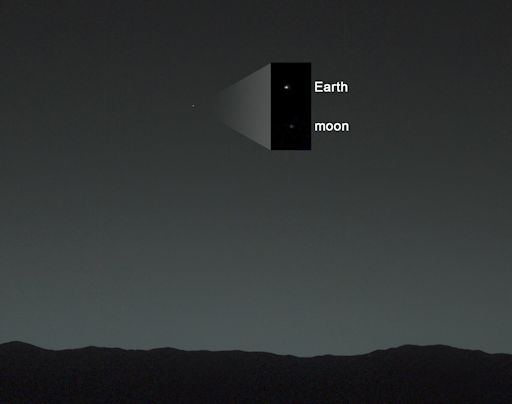 Astro Picture of the Day: February 9, 2014 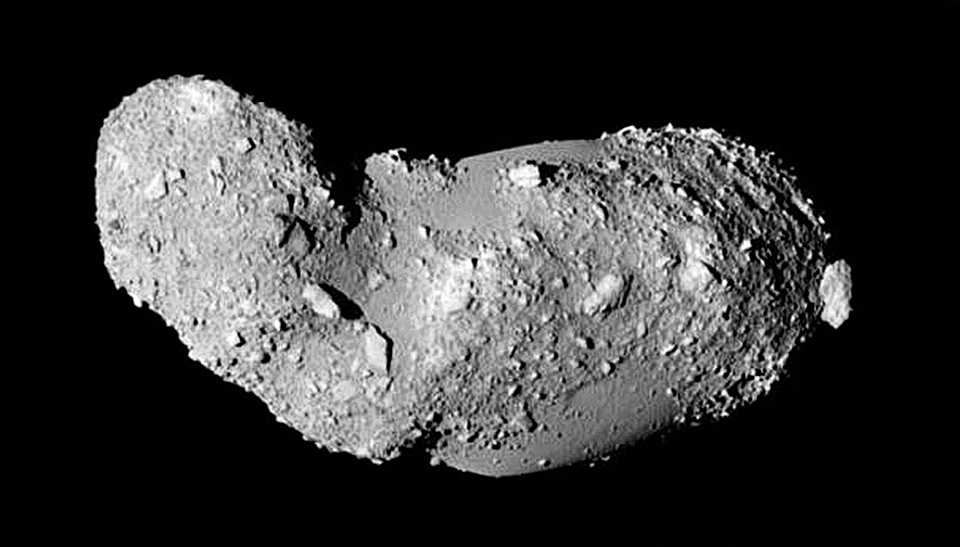 Where are the craters on asteroid Itokawa? Missing - unexpectedly. The Japanese robot probe Hayabusa approached the Earth-crossing asteroid in 2005 and returned pictures showing a surface unlike any other Solar System body yet photographed - a surface possibly devoid of craters. The leading hypothesis for the lack of common circular indentations is that asteroid Itokawa is a rubble pile - a bunch of rocks and ice chunks only loosely held together by a small amount of gravity. If so, craters might not form so easily - or be filled in whenever the asteroid gets jiggled by a passing planet or struck by a massive meteor. Recent Earth-based observations of asteroid Itokawa have shown that one part of the interior even has a higher average interior density than the other part, another unexpected discovery. The Hayabusa mission returned soil samples from Itokawa which are also giving clues the ancient history of the unusual asteroid and our entire Solar System. Daily Suspicious0bserver's Weather Post: February 10, 2014 What's in the sky tonight? February 10, 2014 -The Moon and Jupiter shine about 5° apart this evening (for North America). They're in the feet of Gemini. Although they look close together, Jupiter is 1,630 times farther away — and 40 times larger in diameter. -Today, big sunspots AR1967 and AR1968 are rotating over the sun's western limb to begin a two-week transit of the sun's farside. Ironically, this could result in elevated levels of radiation near Earth. At their current location, the two sunspots are well-connected to our planet by the sun's spiraling magnetic field. Any flares today could funnel energetic particles in our direction, possibly triggering a radiation storm. -Earth's magnetic field is still reverberating from the impact of a CME on Feb. 7th. Intermittent storming around the poles has produced bright auroras across Scandinavia, Iceland and Canada. Zoltan Kenwell sends this picture from Edmonton, Alberta. "I was driving home when I noticed a dim green blob on the eastern horizon," says Kenwell. "I pulled off the highway for a better look and, to my surprise, I saw this corona dancing right above me. The reverberations are subsiding now, but they could begin anew on Sunday when a solar wind stream is expected to sweep past Earth. NOAA forecasters estimate a 45% chance of polar geomagnetic storms on Feb. 9-10. High-latitude sky watchers should remain alert for auroras.  Astro Picture of the Day: February 10, 2014 What would it be like to fall to Earth from really high up? A new record for the highest jump was accomplished in 2012 by Felix Baumgartner. Surpassing the previous record of 31.3 kilometer plummet, Baumgartner, in a commercial venture, jumped off a floating balloon platform 39.0 kilometers above New Mexico, USA and had his entire fall recorded on video. Baumgartner wore a pressurized suit able to provide breathable air and warmth while up in the balloon, but then cooling from the heat generated by the friction if his fall. Free falling 36.4 km before deploying his parachute, Baumgartner surpassed 1,000 km per hour and the sound barrier during the descent. The above video records his four minutes and 19 seconds of free fall in real time. The stunt included a somewhat unexpected but potentially dangerous spin that occurred during the second minute which could have knocked out or disoriented Baumgartner. After an enthralling plummet, Baumgartner's parachutes deployed and he landed safely.
__________________
1st in Kommisar's 2009 SM Tournament 1st in I Love You`s 2009 New Year`s Tournament 3rd in EnR's Mashfest '08 tournament 5th in Phynx's Unofficial FFR Tournament 9th in D3 of the 2008-2009 4th Official FFR Tournament 10th in D5 of the 2010 5th Official FFR Tournament 10th in D6 of the 2011-2012 6th Official FFR Tournament FMO AAA Count: 71 FGO AAA Count: 10 Bluearrowll = The Canadian player who can not detect awkward patterns. If it's awkward for most people, it's normal for Terry. If the file is difficult but super straight forward, he has issues. If he's AAAing a FGO but then heard that his favorite Hockey team was losing by a point, Hockey > FFR PS: Cool AAA's Terry - I Love You An Alarm Clock's Haiku beep beep beep beep beep beep beep beep beep beep beep beep beep beep beep beep beep - ieatyourlvllol |
|
|

|
|
|
#837 |
|
⊙▃⊙
|
Daily Suspicious0bserver's Weather Post:
February 11, 2014 What's in the sky tonight? February 11, 2014 -Jupiter shines above the Moon in early evening. Lower right of the Moon is Procyon, as shown here. Upper left of the Moon are Pollux and, farther on, Castor. -On Sunday, sky watchers around Calgary, Canada, witnessed a magnificent display of ice halos around the sun. "It was magical--the best I've ever seen," reports photographer Dee Cresswell, who needed four exposures to capture all of the glowing arcs. "The temperature was around -22 C, with a windchill in the mid minus thirties," she continues. "You could actually see the ice crystals shimmering in the air. There was a 22° halo, a 46° halo, infralateral arcs, tangent arcs, circumzenithal arc, a parhelic circle and more." Atmospheric optics expert Les Cowley created a diagram labeling the halos. He says they were created by a special kind of ice crystal called "diamond dust." "Diamond dust - that is, low level ice crystals shaped as hexagonal plates and columns - make the very best halos because the crystals are large and of good optical quality," explains Cowley. "Plates made the bright sundogs and the circumzenithal arc while column crystals generated the upper tangent arc and the rarer supralateral and infralateral arcs. More peculiarly oriented columns gave the not often seen Parry arc. A few randomly tilted crystals produced the faint 22-degree halo and only a hint of the 46-degree circle. Supralateral arcs and the rarer 46° halo can be hard to tell apart." "Even though wintry diamond dust is the king of halos,ordinary ice crystals in high clouds can give fine displays all year long," he says. "No matter where you live, or what time of year, keep an eye out for halos." 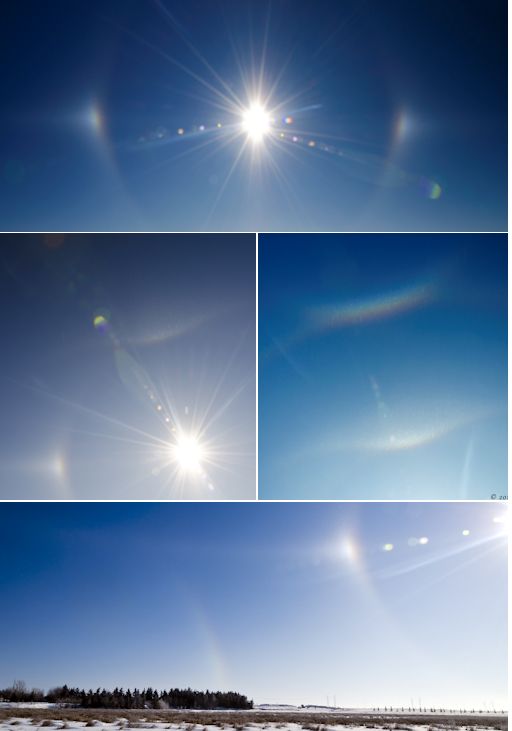 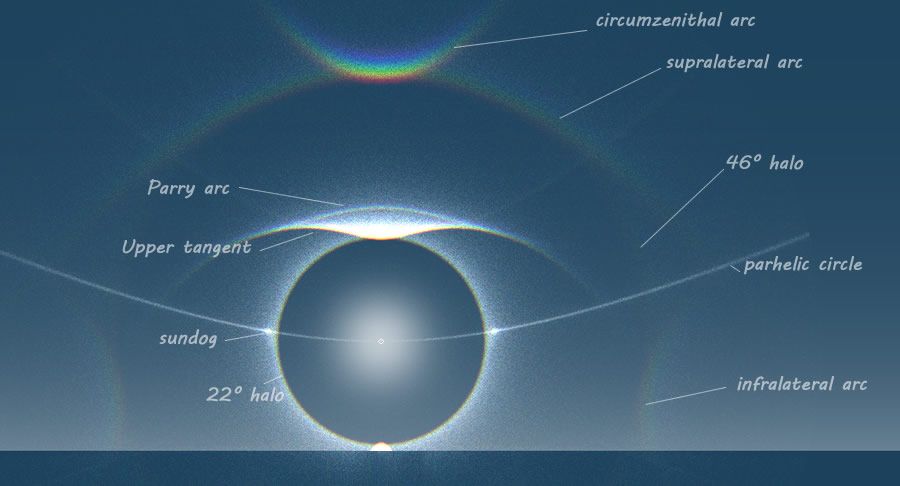 Astro Picture of the Day: February 11, 2014  Is the heart and soul of our Galaxy located in Cassiopeia? Possibly not, but that is where two bright emission nebulas nicknamed Heart and Soul can be found. The Heart Nebula, officially dubbed IC 1805 and visible in the above zoomable view on the right, has a shape reminiscent of a classical heart symbol. Both nebulas shine brightly in the red light of energized hydrogen. Several young open clusters of stars populate the image and are visible above in blue, including the nebula centers. Light takes about 6,000 years to reach us from these nebulas, which together span roughly 300 light years. Studies of stars and clusters like those found in the Heart and Soul Nebulas have focussed on how massive stars form and how they affect their environment.
__________________
1st in Kommisar's 2009 SM Tournament 1st in I Love You`s 2009 New Year`s Tournament 3rd in EnR's Mashfest '08 tournament 5th in Phynx's Unofficial FFR Tournament 9th in D3 of the 2008-2009 4th Official FFR Tournament 10th in D5 of the 2010 5th Official FFR Tournament 10th in D6 of the 2011-2012 6th Official FFR Tournament FMO AAA Count: 71 FGO AAA Count: 10 Bluearrowll = The Canadian player who can not detect awkward patterns. If it's awkward for most people, it's normal for Terry. If the file is difficult but super straight forward, he has issues. If he's AAAing a FGO but then heard that his favorite Hockey team was losing by a point, Hockey > FFR PS: Cool AAA's Terry - I Love You An Alarm Clock's Haiku beep beep beep beep beep beep beep beep beep beep beep beep beep beep beep beep beep - ieatyourlvllol |
|
|

|
|
|
#838 |
|
⊙▃⊙
|
Daily Suspicious0bserver's Weather Post:
February 12, 2014 What's in the sky tonight? February 12, 2014 -To the right of the Moon this evening, by more than a fist-width at arm's length, sparkles Procyon, the Little Dog Star, one of our near stellar neighbors at a distance of 11.5 light-years. About twice as far to Procyon's lower right is brighter Sirius, the Big Dog Star, only 8.6 light-years away. -The biggest and brightest asteroids, 1 Ceres and 4 Vesta respectively, are only about 4° apart in eastern Virgo in the early morning hours. They're magnitude 8.1 and 7.1, respectively. -Two minor CMEs that left the sun on Feb. 11th are expected to merge and hit Earth's magnetic field on Feb. 14th. The combined impact could spark geomagnetic storms and auroras around the Arctic Circle on Valentine's Day. -Sunspot AR1974 is growing rapidly and poses an increasing chance of Earth-directed flares. During the past two days, the sunspot has sprouted dozens of new dark cores under an increasingly complex magnetic canopy. The region's unstable 'beta-gamma-delta' magnetic field harbors energy for strong explosions, prompting NOAA forecasters to boost the daily odds of M-flares to 45%, and X-flares to 10%. 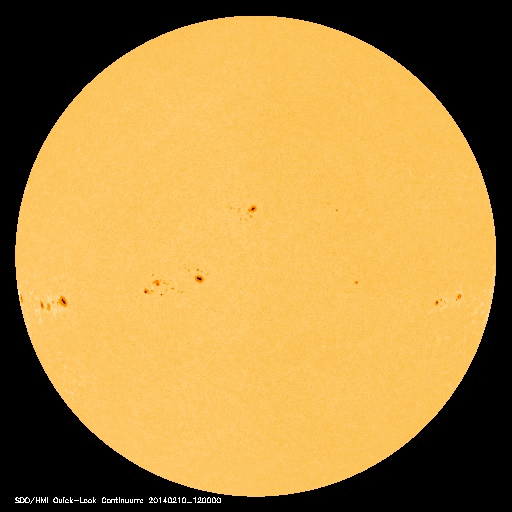 Astro Picture of the Day: February 12, 2014  Can the night sky appear both serene and surreal? Perhaps classifiable as serene in the above panoramic image taken last Friday are the faint lights of small towns glowing across a dark foreground landscape of Doi Inthanon National Park in Thailand, as well as the numerous stars glowing across a dark background starscape. Also visible are the planet Venus and a band of zodiacal light on the image left. Unusual events are also captured, however. First, the central band of our Milky Way Galaxy, while usually a common site, appears here to hover surreally above the ground. Next, a fortuitous streak of a meteor was captured on the image right. Perhaps the most unusual component is the bright spot just to the left of the meteor. That spot is the plume of a rising Ariane 5 rocket, launched a few minutes before from Kourou, French Guiana. How lucky was the astrophotographer to capture the rocket launch in his image? Not lucky at all - the image was timed to capture the rocket. What was lucky was how photogenic - and perhaps surreal - the rest of the sky turned out to be.
__________________
1st in Kommisar's 2009 SM Tournament 1st in I Love You`s 2009 New Year`s Tournament 3rd in EnR's Mashfest '08 tournament 5th in Phynx's Unofficial FFR Tournament 9th in D3 of the 2008-2009 4th Official FFR Tournament 10th in D5 of the 2010 5th Official FFR Tournament 10th in D6 of the 2011-2012 6th Official FFR Tournament FMO AAA Count: 71 FGO AAA Count: 10 Bluearrowll = The Canadian player who can not detect awkward patterns. If it's awkward for most people, it's normal for Terry. If the file is difficult but super straight forward, he has issues. If he's AAAing a FGO but then heard that his favorite Hockey team was losing by a point, Hockey > FFR PS: Cool AAA's Terry - I Love You An Alarm Clock's Haiku beep beep beep beep beep beep beep beep beep beep beep beep beep beep beep beep beep - ieatyourlvllol |
|
|

|
|
|
#839 |
|
⊙▃⊙
|
Daily Suspicious0bserver's Weather Post:
February 13, 2014 What's in the sky tonight? February 13, 2014 -The wheel of the year is turning, and spring is only a little more than a month away. So by 9 or 10 p.m. (depending on your location), you'll find the Big Dipper already standing on its handle in the northeast as high as Cassiopeia has descended in the northwest. -Saturn (magnitude +0.5, in Libra) rises around 1 a.m. and is highest in the south at dawn. By then it's far to the left of Mars and Spica (by 28°). Look for Antares 18° to Saturn's lower left. This week Saturn is at western quadrature (90° west of the Sun). Astro Picture of the Day: February 13, 2014  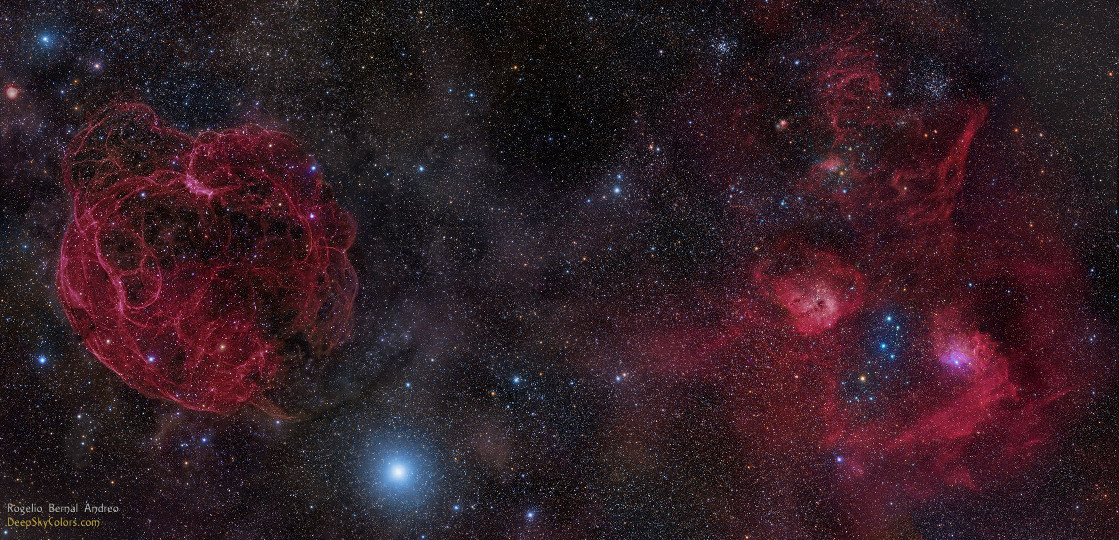 Rich in star clusters and nebulae, the ancient constellation of Auriga, the Charioteer, rides high in northern winter night skies. Spanning nearly 24 full moons (12 degrees) on the sky, this deep telescopic mosaic view recorded in January shows off some of Auriga's most popular sights for cosmic tourists. The crowded field sweeps along the plane of our Milky Way galaxy in the direction opposite the galactic center. Need directions? Near the bottom of the frame, at the Charioteer's boundary with Taurus the Bull, the bright bluish star Elnath is known as both Beta Tauri and Gamma Aurigae. On the far left and almost 300 light-years away, the busy, looping filaments of supernova remnant Simeis 147 cover about 150 light-years. Look toward the right to find emission nebula IC 410, significantly more distant, some 12,000 light-years away. Star forming IC 410 is famous for its embedded young star cluster, NGC 1893, and tadpole-shaped clouds of dust and gas. The Flaming Star Nebula, IC 405, is just a little farther along. Its red, convoluted clouds of glowing hydrogen gas are energized by hot O-type star AE Aurigae. Two of our galaxy's open star clusters, Charles Messier's M36 and M38 line up in the starfield above, familiar to many binocular-equipped skygazers.
__________________
1st in Kommisar's 2009 SM Tournament 1st in I Love You`s 2009 New Year`s Tournament 3rd in EnR's Mashfest '08 tournament 5th in Phynx's Unofficial FFR Tournament 9th in D3 of the 2008-2009 4th Official FFR Tournament 10th in D5 of the 2010 5th Official FFR Tournament 10th in D6 of the 2011-2012 6th Official FFR Tournament FMO AAA Count: 71 FGO AAA Count: 10 Bluearrowll = The Canadian player who can not detect awkward patterns. If it's awkward for most people, it's normal for Terry. If the file is difficult but super straight forward, he has issues. If he's AAAing a FGO but then heard that his favorite Hockey team was losing by a point, Hockey > FFR PS: Cool AAA's Terry - I Love You An Alarm Clock's Haiku beep beep beep beep beep beep beep beep beep beep beep beep beep beep beep beep beep - ieatyourlvllol |
|
|

|
|
|
#840 |
|
⊙▃⊙
|
Daily Suspicious0bserver's Weather Post:
February 14, 2014 What's in the sky tonight? February 14, 2014 -Full Moon (exactly full at 6:53 p.m. EST). Look for Regulus in Leo to the Moon's left during evening, as shown here. A February full Moon is never far from Regulus. -Algol in Perseus should be at its minimum light, magnitude 3.4 instead of its usual 2.1, for a couple hours centered on about 10:30 p.m. EST (7:30 p.m. PST). Algol takes several additional hours to fade and to rebrighten.  News Posted Today: February 14, 2014 Unveiling Ganymede  Astro Picture of the Day: February 14, 2014  Sprawling across almost 200 light-years, emission nebula IC 1805 is a mix of glowing interstellar gas and dark dust clouds about 7,500 light-years away in the Perseus spiral arm of our galaxy. Stars were born in this region whose nickname, the Heart Nebula, derives from its Valentine's-Day-appropriate shape. The clouds themselves are shaped by stellar winds and radiation from massive hot stars in the nebula's newborn star cluster Melotte 15 about 1.5 million years young. This deep telescopic image maps the pervasive light of narrow emission lines from atoms in the nebula to a color palette made popular in Hubble images of star forming regions. The field of view spans about two degrees on the sky or four times the diameter of a full moon. The cosmic heart is found in the constellation of Cassiopeia, the boastful mythical Queen of Aethiopia. Daily Suspicious0bserver's Weather Post: February 15, 2014 What's in the sky tonight? February 15, 2014 -This is the time of year when, soon after dark, skywatchers at mid-northern latitudes see bright Capella crossing near the zenith and Orion standing highest in the south. Orion's diagonal belt points lower left toward bright Sirius, and upper right more or less toward Aldebaran. Beyond Aldebaran lie the Pleiades.   Astro Picture of the Day: February 15, 2014  This helmet-shaped cosmic cloud with wing-like appendages is popularly called Thor's Helmet. Heroically sized even for a Norse god, Thor's Helmet is about 30 light-years across. In fact, the helmet is more like an interstellar bubble, blown as a fast wind from the bright, massive star near the bubble's center sweeps through a surrounding molecular cloud. Known as a Wolf-Rayet star, the central star is an extremely hot giant thought to be in a brief, pre-supernova stage of evolution. Cataloged as NGC 2359, the nebula is located about 15,000 light-years away in the constellation Canis Major. The sharp image, made using broadband and narrowband filters, captures striking details of the nebula's filamentary structures. It shows off a blue-green color from strong emission due to oxygen atoms in the glowing gas.
__________________
1st in Kommisar's 2009 SM Tournament 1st in I Love You`s 2009 New Year`s Tournament 3rd in EnR's Mashfest '08 tournament 5th in Phynx's Unofficial FFR Tournament 9th in D3 of the 2008-2009 4th Official FFR Tournament 10th in D5 of the 2010 5th Official FFR Tournament 10th in D6 of the 2011-2012 6th Official FFR Tournament FMO AAA Count: 71 FGO AAA Count: 10 Bluearrowll = The Canadian player who can not detect awkward patterns. If it's awkward for most people, it's normal for Terry. If the file is difficult but super straight forward, he has issues. If he's AAAing a FGO but then heard that his favorite Hockey team was losing by a point, Hockey > FFR PS: Cool AAA's Terry - I Love You An Alarm Clock's Haiku beep beep beep beep beep beep beep beep beep beep beep beep beep beep beep beep beep - ieatyourlvllol |
|
|

|
 |
| Currently Active Users Viewing This Thread: 1 (0 members and 1 guests) | |
|
|